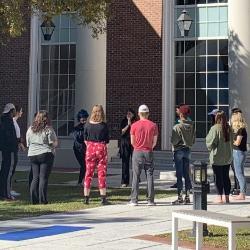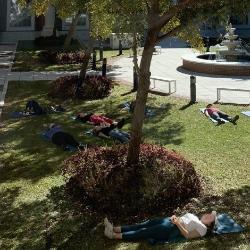
Meditation in the Edwards Courtyard
Kaitlyn Maines-Presley, Edwards College Director of Student Success, Recruitment, and Career Transition, held a series of six student success classes this semester that involved a wide range of topics and activities. For one of the meetings, she invited Sophia Karatza, associate professor of intercultural communication in the Department of Communication, Media and Culture, to lead a meditation class in the Edwards Courtyard. Karatza said the class “combined meditation and cultural awareness methodologies to reduce stress and to increase bonding and a sense of belonging within the group.”
After receiving a great deal of positive feedback from students, Maines-Presley interviewed Karatza about her perspective on the activity.
 K M-P: Why meditation for student success?
K M-P: Why meditation for student success?
SK: In our culture, we tend to think of student success in very limited ways—namely, grades. And we tend to think of the path to success in very simplistic terms—namely, study hours. Meditation not only “drains water from our boat,” so to speak, but also gives us new ways to think about the sea: new maps, fresh travel destinations, excitement and curiosity for lands we have not yet been. Having being raised in Greece and Cyprus, sea metaphors come easily to me. Overall, meditation helps the mind relax and allows for quality work instead of quantity, curiosity instead of anxiety, and the ability to stay present and aware. As an educator, I would say these are also the secrets to student success—the kind of success that lasts and keeps on giving later in career and life.
K M-P: This session looked different than meditation classes I have seen before. What was it?
SK: It is true; most people tend to think of meditation as sitting down, alone, in a quiet room with music or without, trying to “focus on their mind not focusing on anything.” You may be hearing the paradox in that. It is also my experience that we are all different with different needs, so one way of meditating does not fit all. Simply put, diversity in needs requires diversity in approaches and methods. So, in meditation, I do not focus on stillness, seriousness, and aloneness. Instead, I focus on togetherness and on movement—on continuous, playful, and conscious movement. This practice tends to increase vitality, joy, and curiosity within by helping us return to the present moment, to the appreciation of life in the “now.” This appreciation encompasses the self, the people around us, and the natural environment. It helps us pause, breathe, and reassess what really matters in terms of belonging in this world.
 K M-P: So, what would you say meditation is? And why would someone try it?
K M-P: So, what would you say meditation is? And why would someone try it?
SK: Meditation, at least the way I study and practice it, means to be present in the moment and to be observant. First, being present for the self, being aware of one’s own feelings, positive and negative, and accepting the self as it is, unconditionally and with love. When we accept ourselves unconditionally, and we acknowledge we have feelings—but we are not our feelings—we can get “unstuck” from old patterns of thinking and feeling. And then, we can also accept others in love and compassion—we can meet them where they are, unconditionally. To me, that is the foundation of a culture of belonging and the best booster for success: that your best interest is my best interest; my awareness becomes your awareness; and our growth is the collective good as a community. In sum, meditation reminds me that we are all interconnected and one.
K M-P: I heard you saying that students can use these activities in everyday life to release some tension and feel joy. What else are these techniques good for?
SK: They help with burnout. They reassure us that if we are just a little patient, if we remember that all feelings will pass, if we only keep moving, we will persevere. It does not matter how fast or slow; as long as we keep moving in the rhythm of the moment, we can find comfort and delight in the freshness of the now. For me, this fresh perspective is the real success. Can a student think about an old problem in an original way? Can a student think creatively about opportunities in learning, beyond information? Can a student get absorbed in the joy and get devoted to the passion of a new idea? That is what deep learning means to me: distancing ourselves from the old and boring narratives of the mind, and exploring new possibilities for growth, enjoying the freshness and the creative opportunities of the moment, of every single moment.
K M-P: One last question: Why here, in the Edwards courtyard?
SK: Ah, this space is sacred for many of us, a shelter of some sort. Many students come here to take a break and breathe, listen to the fountain, find quiet and calmness. Very consciously, I chose to capitalize on the existing value that this place holds for many students and increase the volume of that experience. Students have access to this place; many come by here almost every day, so the memory and sensory experience of this meditation will only strengthen students’ existing bond to it as a place that quietens the mind and relaxes the body. I also chose this space as a reminder that we should use all the resources that the beautiful Coastal campus and the incredible Coastal community have to offer. Sometimes all we need is already there, already provided, and we just need to pause and receive.
K M-P: This is fascinating, Dr. Karatza. Thank you so much for talking to us today.
SK: Thank you very much for the opportunity to share this experience. And many thanks to you and the Edwards College for always working with our students to bring them new opportunities for growth and success.





